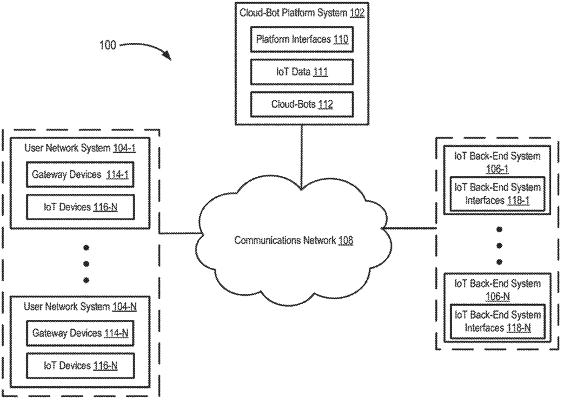| CPC G05B 15/02 (2013.01) [H04L 67/125 (2013.01); H04W 4/70 (2018.02)] | 20 Claims |

|
1. A cloud-based computing system comprising:
one or more processors; and
memory storing instructions that, when executed by the one or more processors, cause the cloud-based system to perform:
storing, by the cloud-based system, a plurality of cloud-bots, each of the plurality of cloud-bots including a respective service, each of the cloud-bots being selectable to support one or more user accounts;
receiving selection of a set of particular cloud-bots of the plurality of cloud-bots for a particular user account of the one or more user accounts, one particular cloud-bot of the set of particular cloud-bots having a sleep state and an execution state, the particular cloud-bot being operative when in the execution state to monitor for a response condition, the response condition being dependent on data from two or more different Internet-of-Things (IoT) devices;
for the particular user account,
associating, by the cloud-based system, a particular instance of the one particular cloud-bot with a first IoT device and with a second IoT device, the first IoT device being managed by a first cloud-based IoT back-end system remote from the first IoT device, the first IoT device including a first sensor for sensing a first ambient condition of a first type and not of a second type, the second IoT device including a second sensor for sensing a second ambient condition of the second type and not the first type, the first IoT device configured to send first data on the first ambient condition to the first cloud-based IoT back-end system, the second IoT device configured to capture second data on the second ambient condition;
gathering, by the cloud-based system, first information based on the first data over a communication network, the first information being received from the first cloud-based IoT back-end system;
gathering, by the cloud-based system, second information based on the second data over the communication network, the second information being received from the second IoT device;
monitoring the first information and the second information to determine whether satisfaction of a trigger condition associated with the one particular cloud-bot has occurred;
upon satisfaction of the trigger condition, causing the one particular cloud-bot to transition from the sleep state to the execution state, the one particular cloud-bot having a particular cloud-bot model, the particular cloud-bot model defining a response condition, the response condition being based on a likelihood of an event having happened or expected to happen;
evaluating, by the one particular cloud-bot, at least the first information and the second information against the response condition of the particular cloud-bot model of the one particular cloud-bot to determine the likelihood of an event having happened or expected to happen;
initiating, by the one particular cloud-bot, one or more response actions in response to satisfaction of the response condition, the one or more response actions including controlling one or more device actions of a particular IoT device; and
upon satisfaction of a sleep condition, transitioning the one particular cloud-bot to the sleep state.
|